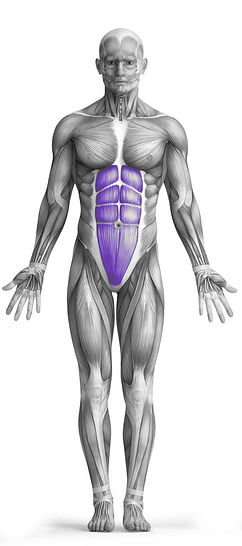Shoulder Tap 101 Video Tutorial
0

Exercise Synopsis
Target Muscle Group
Abs
Secondary Targets
None
Execution
Compound
Force Type
Isometric
Required Equipment
Bodyweight
Fitness Level
Intermediate
Variations
None
Alternatives
None
Timer
Hour
Minute
Second
Stopwatch
00:00:00:00
Overview
The "Shoulder Tap" is a core-strengthening exercise that primarily targets the abdominal muscles. This bodyweight exercise involves starting in a high plank position, with hands placed directly under the shoulders and the body forming a straight line from head to heels. The exercise is performed by alternately lifting one hand off the ground to tap the opposite shoulder, while maintaining stability and minimizing hip rotation to engage the abs effectively. As there are no secondary target muscles, the focus remains on enhancing core stability and strength without the need for any additional equipment.
How to Perform
Start in a plank position with your hands placed directly under your shoulders and your feet set slightly wider than shoulder-width apart for stability.
Gradually lift one hand off the ground and touch the opposite shoulder, ensuring your core remains tight and your hips stay level.
Place your hand back on the floor in the starting position.
Repeat the movement with your other hand, touching the opposite shoulder.
Continue alternating sides, completing the desired number of repetitions, while maintaining a stable and straight body line throughout the exercise.
★ Bonus: For exercises that involve external weights (such as dumbbells, barbells, or machines), the One Rep Max (1RM) calculator can help you estimate your maximum lifting capacity. Use it to track your strength progress and adjust your training for optimal results.
Tips
Focus on keeping your hips steady throughout the movement. Visualize balancing a cup of water on your lower back as you lift each hand.
Maintain normal breathing, avoiding breath-holding. Your stability should come from your core, not your breath.
Spread your fingers wide on the ground to increase your support base and enhance sensory feedback through your hands.
Keep your neck in a neutral position, with your eyes looking at the floor just in front of your fingertips during each repetition.
How Not to Perform
Avoid Letting Hips Sag or Rise:
Do not let your hips drop towards the floor or lift too high. This can reduce the effectiveness of the exercise on your abs and potentially strain your lower back. Maintain a straight line from head to heels.
Do Not Rotate Your Hips:
Prevent your hips from twisting or rotating as you lift each hand. Excessive movement in your hips can diminish the focus on your abdominal muscles and lead to instability.
Do Not Hold Your Breath:
Avoid holding your breath during the exercise. Proper breathing is crucial for maintaining core stability and preventing unnecessary tension.
Avoid Rushing the Movement:
Don’t perform the taps too quickly. Rapid movements can lead to poor form and decreased muscle engagement. Perform each tap slowly and with control.
Do Not Lock Your Elbows:
Keep a slight bend in your elbows rather than locking them out. Locked elbows can lead to joint strain and reduce the engagement of your core muscles.
Avoid Letting Your Feet Come Together:
Don’t let your feet move closer together during the exercise. Keeping them slightly wider than shoulder-width apart helps maintain balance and core engagement.
Do Not Look Up:
Keep your head and neck in a neutral position. Looking up can strain your neck and disrupt the alignment of your spine. Keep your gaze on the floor just in front of your fingertips.
Avoid Uneven Weight Distribution:
Make sure not to shift all your weight to one side when lifting a hand. This can cause imbalance and reduce the effectiveness of the exercise on your core.
Do Not Rush the Repetitions:
Each repetition should be performed with focus and control. Rushing through reps can lead to sloppy form and reduced engagement of the target muscle group.
Avoid Losing Focus on Form:
Maintain constant awareness of your form throughout the exercise. Letting your form slip can lead to inefficient movement and increased risk of injury.
Variations
Variations of fitness exercises refer to different ways of performing a specific exercise or movement to target various muscle groups, intensities, or goals. These variations aim to challenge the body differently, prevent plateaus, and cater to individuals with varying fitness levels.
Alternatives
Alternative exercises in fitness refer to different movements or activities that target similar muscle groups or serve the same training purpose as the primary exercise. These alternative exercises can be used as substitutes when the original exercise is unavailable or challenging to perform due to various reasons such as equipment limitations, injuries, or personal preferences.








